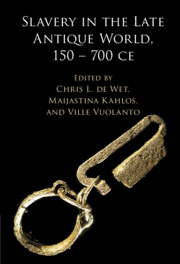Book contents
- Slavery in the Late Antique World, 150–700 CE
- Slavery in the Late Antique World, 150–700 CE
- Copyright page
- Contents
- Figures
- Tables
- Contributors
- Preface
- A Note on Abbreviations and Sources Used
- Introduction Late Antique Studies and the New Polyphony for Slave Studies
- Part I Moral and Symbolic Values of Slavery
- Part II Slavery, Cultural Discourses, and Identity
- Part III Slavery, Social History, and the Papyrological and Epigraphical Sources
- 9 Slaves in Sixth-Century Palestine in the Light of Papyrological Evidence
- 10 Enslaved Children in Roman Egypt: Experiences from the Papyri
- 11 Late Antique Slavery in Epigraphic Evidence
- Part IV Social and Religious Histories of Slavery on the Borders of the Empire and Beyond
- Bibliography
- Index
11 - Late Antique Slavery in Epigraphic Evidence
from Part III - Slavery, Social History, and the Papyrological and Epigraphical Sources
Published online by Cambridge University Press: 27 January 2022
- Slavery in the Late Antique World, 150–700 CE
- Slavery in the Late Antique World, 150–700 CE
- Copyright page
- Contents
- Figures
- Tables
- Contributors
- Preface
- A Note on Abbreviations and Sources Used
- Introduction Late Antique Studies and the New Polyphony for Slave Studies
- Part I Moral and Symbolic Values of Slavery
- Part II Slavery, Cultural Discourses, and Identity
- Part III Slavery, Social History, and the Papyrological and Epigraphical Sources
- 9 Slaves in Sixth-Century Palestine in the Light of Papyrological Evidence
- 10 Enslaved Children in Roman Egypt: Experiences from the Papyri
- 11 Late Antique Slavery in Epigraphic Evidence
- Part IV Social and Religious Histories of Slavery on the Borders of the Empire and Beyond
- Bibliography
- Index
Summary
While slavery was entrenched in the high Roman Empire, it continued well into late antiquity. The aim of this article is to evaluate the overall state of the evidence and to discuss the epigraphic and material culture of late Roman slavery, focusing on inscriptional sources for slaves in the later Roman Empire. I contend that the comprehensive overview of this type of evidence enables one to reintegrate the textual, visual, and physical aspects of artefacts of the period and to move the discussion about slavery and material culture forwards, by employing the intersectional approach. To be sure, late Roman slaves were not ‘class for itself’, while ‘class in itself’ they certainly were. They left a visible footprint in archaeological sites, and the epigraphic record that survives from the later Empire holds anthropological information about Roman slave culture: social interactions and a hierarchy of statuses, values, and beliefs.
Keywords
- Type
- Chapter
- Information
- Slavery in the Late Antique World, 150 – 700 CE , pp. 224 - 248Publisher: Cambridge University PressPrint publication year: 2022

